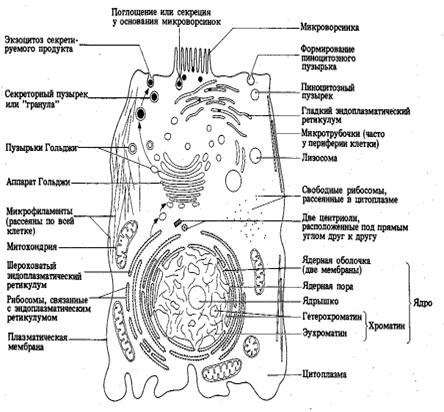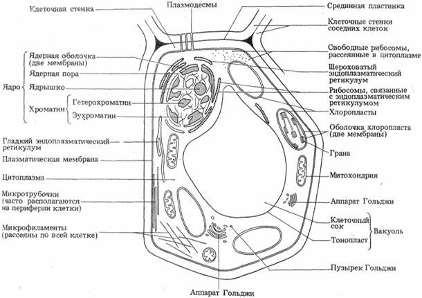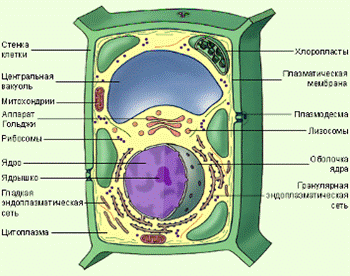Animal structure and plant cell
Different in structure eukaryotic cells similar. But along with the similarities between the cells of organisms of different kingdoms of living nature, there are noticeable differences. They relate to both structural and biochemical features.
The figures show a schematic and three-dimensional image of animal and plant cells with the location of organelles and inclusions in them.

Figure 10 - Construction diagrams animal cell.
The cell cytoplasm contains a number of the smallest structures performing various functions. These membrane-bounded cellular structures are called organelles The nucleus, mitochondria, lysosomes, chloroplasts are cellular organelles. Organelles can be separated from the cytosol by a single or double layer membrane.
The main function of the membrane is to allow movement through it. various substances from cell to cell. In this way, the exchange of substances between cells and intercellular substance. Also, a plant cell has a rigid cell wall above a membrane. The cell walls of neighboring cells are separated by a middle plate, and to carry out metabolism in the cell walls there is a system of holes - plasmodesmata.
Figure 11 shows diagrams of the structure of a plant cell.


Figure 11 – Schemes of the structure of a plant cell
A plant cell is characterized by the presence of various plastids, a large central vacuole, which sometimes pushes the nucleus to the periphery, as well as a cell wall located outside the plasma membrane, consisting of cellulose. In the cells of higher plants, the cell center lacks a centriole, which is found only in algae. The reserve nutrient carbohydrate in plant cells is starch.
So, main organelles of animal and plant cells:
nucleus and nucleolus; ribosomes; endoplasmic reticulum (ER), Golgi apparatus, lysosomes, vacuoles, mitochondria, plastids, cell center (centrioles)
Cytoplasm is the internal semi-liquid environment of cells, bounded by the plasma membrane, in which they are located nucleus and other organelles. The most important role of the cytoplasm is to unite all cellular structures and ensure their chemical interaction.
Various
§ inclusion(temporary formations) - containing insoluble waste of metabolic processes and reserve nutrients;
§ vacuoles;
§ the thinnest tubes and filaments that form the skeleton of the cell.
The composition of the cytoplasm includes all types of organic and inorganic substances. The main substance of the cytoplasm contains a significant amount of proteins and water. The main metabolic processes take place in it, it ensures the interconnection of the nucleus and all organelles and the activity of the cell as a single integral living system. Cytoplasm is constantly moving, flowing inside a living cell, moving with it various substances, inclusions and organelles. This movement is called cyclosis.
All living organisms have many similarities cellular structure. However, cells from different kingdoms of life have their own characteristics. So bacterial cells do not have nuclei, but plant cells have hard cellulose cell wall and chloroplasts. The structure of animal cells also has its own characteristic features.
Most often, animal cells are smaller than plant cells. They are very diverse in shape. The shape and structure of an animal cell depends on the functions it performs. Complex animals have bodies made up of many tissues. Each tissue is made up of its own cells, which have their own characteristic structural features. But despite all the diversity, it is possible to identify common features in the structure of all animal cells.
The contents of an animal cell are limited from the external environment only cell membrane. It is elastic, so many cells have irregular shape, may change it slightly. The membrane has a complex structure; it consists of two layers. The cell membrane is responsible for the selective transport of substances into and out of the cell.
Inside an animal cell there is cytoplasm, a nucleus, organelles, ribosomes, various inclusions, etc. Cytoplasm represents viscous liquid located in constant movement. The movement of the cytoplasm contributes to the occurrence of various chemical reactions in the cell, i.e. metabolism.
An adult plant cell has a large central vacuole. There is no such vacuole in an animal cell. However, in animal cells small vacuoles. They may contain nutrients for the cell or waste products that need to be removed.
The structure of an animal cell differs from a plant cell in that in an animal cell there is a fairly large core usually located in the center (and in plants it is displaced due to the presence of a large central vacuole). Inside the nucleus contains nuclear juice, and also contains nucleolus And chromosomes. Chromosomes contain hereditary information that, when divided, is passed on to daughter cells. They also control the functioning of the cells themselves.
The nucleus has its own membrane that separates its contents from the cytoplasm. In addition to the nucleus, the cytoplasm of the cell contains other structures that have their own membranes. These structures are called cell organelles, or, in other words, cell organelles. In a normal animal cell, in addition to the nucleus, there are the following organelles: mitochondria, endoplasmic reticulum (ER), Golgi apparatus, lysosomes.
Mitochondria- these are the energy stations of the cell. They produce ATP - organic matter, subsequently, when split, a lot of energy is released, which ensures the flow of vital processes in the cell. Inside the mitochondria there are many folds - cristae.
Endoplasmic reticulum consists of many channels through which proteins synthesized in the cell, as well as other substances, are transported. Through the EPS channels, substances enter the Golgi apparatus, which is more pronounced in animal cells than in plant cells. In the Golgi apparatus, which is a complex of tubules, substances accumulate. Further, as needed, they will be used in the cage. In addition, the synthesis of fats and carbohydrates occurs on the membrane of the Golgi apparatus to build all cell membranes.
IN lysosomes contains substances that break down unnecessary and harmful proteins, fats and carbohydrates for the cell.
In addition to organelles surrounded by a membrane, animal cells have non-membrane structures: ribosomes and the cell center. Ribosomes are found in the cells of all organisms, not just animals. But plants do not have a cell center.
Ribosomes located in groups on the endoplasmic reticulum. EPS covered with ribosomes is called rough. Without ribosomes, the ER is called smooth. Protein synthesis occurs on ribosomes.
Cell center consists of a pair of cylindrical bodies. At a certain stage, these bodies create a kind of fission spindle, which contributes to the correct segregation of chromosomes during cell division.
Cellular inclusion are various drops and grains consisting of proteins, fats and carbohydrates. They are constantly present in the cytoplasm of the cell and participate in metabolism.
, animal cells have a core and other elements that perform specific functions. Since these functions are similar in all animals, we can conclude that eukaryotes have in common evolutionary origin. This is also proof of their unity.
Cellular elements work in a coordinated manner. This coordination is ensured by protoplasm, in which core And cytoplasm . The main structural elements of an animal cell are cell membrane (plasmalemma) and organoids - endoplasmic reticulum, Golgi apparatus, ribosomes, mitochondria, microtubules, microfilaments and lysosomes. The nucleus is always present, only red blood cells of mammals lack it for the second time. In addition, the cytoplasm of animal cells may contain temporary inclusions, products of cellular metabolism - droplets fat, glycogen clumps, pigments, etc.
Cells are bounded on the outside by a membrane, the structure and properties of which are common to all types of cells. That's why they call her elementary membrane. The thickness of the membrane reaches 5-10 nm. Its structure is peculiar. It consists of two outer and one inner layer (Fig. 3). The outer layers are formed protein molecules, and the internal one - a double row of phospholipid molecules.
The functions of elementary membranes are diverse. First of all, the membrane is a living barrier that separates intracellular contents from the external environment, which is especially important for single-celled organisms. At the same time, it acts as a diffusion boundary - it delimits intracellular and intercellular sites of reactions and creates gradients of concentrations of substances. Due to selective permeability for K +, Na +, Cl - ions, the membrane also creates an electrical gradient. Substances can pass through the membrane along a concentration gradient (so-called passive transport), but they can also move against it. In this case, they talk about active transport, which requires special mechanisms and is carried out with the expenditure of energy. Substances enter the cell in both liquid (pinocytosis) and solid (phagocytosis) form. However, this already applies to nutrition.
The functions of membranes are not limited to this. Membranes are capable of storing, converting and spending energy, very complex reactions take place in them, and under normal conditions for the body, and, finally, membranes are ultra-sensitive receivers and converters of various kinds of signals coming from the external environment. In practice, the membrane directly or indirectly takes part in any biological processes. Material from the site
Between neighboring cells there are areas where the membranes are closely adjacent to each other. In other areas between the cells there are gaps filled with intercellular substance, which ensures chemical and electrical integration of neighboring cells. Cellular contacts of sensory, nerve and muscle cells are represented by synapses.
In unicellular animals, the body is represented by one cell that performs all functions. In multicellular organisms, identically arranged cells are part of functionally different complexes called fabrics. Many types of tissues are common in animals. The main ones are epithelial, limiting the outer surfaces and internal cavities, and connective, performing mainly a supporting function. As well as specialized tissues - muscle, nervous and glandular.
On this page there is material on the following topics:
